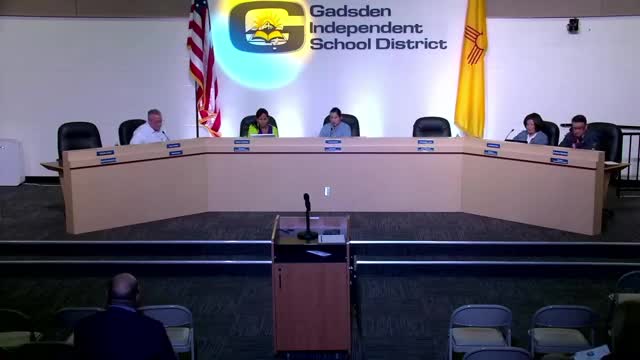Gadsden ISD outlines secondary literacy plan: MLSS emphasis, AIM Pathway early start and disciplinary literacy coaching
April 26, 2025 | GADSDEN INDEPENDENT SCHOOLS, School Districts, New Mexico
This article was created by AI summarizing key points discussed. AI makes mistakes, so for full details and context, please refer to the video of the full meeting. Please report any errors so we can fix them. Report an error »

District academic leaders presented a multi‑tiered approach to secondary literacy and intervention that centers classroom instruction and district professional development while expanding targeted interventions for students who need additional support.
The nut graf: The presentation emphasized that secondary literacy work centers on layered supports (MLSS — multilayered system of supports) and disciplinary literacy approaches tied to the science of reading. The district said it started implementation early on state programs for middle schools and is building teacher coaching, diagnostic options and a menu of intervention tools.
Academic services staff described the district’s layered approach: layer 1 strategies target all students in classroom instruction; layer 2 provides targeted supports within the classroom; and layer 3 is more intensive intervention still delivered with classroom collaboration. The district has partnered with SREB (Making Schools Work) to train secondary teachers in “powerful literacy practice,” and reported about 80 secondary teachers have participated in that professional learning so far.
The district described AIM Pathway to Reading (a New Mexico Public Education Department initiative tied to the science of reading) as a statewide program that will train all secondary ELA teachers; GISD said it received an early‑start grant this year for its three middle schools and one sixth‑grade site to begin training ahead of a statewide rollout. The district reported 25 schools in the state were awarded early‑start grants and that GISD’s three middle schools were among them.
District staff also described disciplinary literacy, which adapts reading and writing instruction to the genres and documents specific to each content area (for example, primary sources in social studies or lab reports in science). Nancy Torres, the district’s secondary ELA specialist, explained disciplinary literacy differs from elementary “learning to read” instruction because secondary students must “read to learn” across content areas.
On targeted interventions, presenters listed district tools (named in the transcript as “Flashlight 360,” Reading Plus, Imagine Learning and Momentum) that are used in ELD and special‑education settings and said intervention teachers are embedded at middle schools. The team said interventionists work alongside classroom teachers in PLCs and use proficiency scales to plan small‑group work. Staff said summer learning is intended more for application projects (for example, makerspace, drones or horticulture projects) rather than direct repetition of interventions.
Ending: Presenters said the district will continue pursuing grants and targeted professional development (including WestEd’s Reading Apprenticeship) and is evaluating diagnostic assessments for secondary grades to better measure proficiency out of high school. No formal policy change was proposed at the meeting.
The nut graf: The presentation emphasized that secondary literacy work centers on layered supports (MLSS — multilayered system of supports) and disciplinary literacy approaches tied to the science of reading. The district said it started implementation early on state programs for middle schools and is building teacher coaching, diagnostic options and a menu of intervention tools.
Academic services staff described the district’s layered approach: layer 1 strategies target all students in classroom instruction; layer 2 provides targeted supports within the classroom; and layer 3 is more intensive intervention still delivered with classroom collaboration. The district has partnered with SREB (Making Schools Work) to train secondary teachers in “powerful literacy practice,” and reported about 80 secondary teachers have participated in that professional learning so far.
The district described AIM Pathway to Reading (a New Mexico Public Education Department initiative tied to the science of reading) as a statewide program that will train all secondary ELA teachers; GISD said it received an early‑start grant this year for its three middle schools and one sixth‑grade site to begin training ahead of a statewide rollout. The district reported 25 schools in the state were awarded early‑start grants and that GISD’s three middle schools were among them.
District staff also described disciplinary literacy, which adapts reading and writing instruction to the genres and documents specific to each content area (for example, primary sources in social studies or lab reports in science). Nancy Torres, the district’s secondary ELA specialist, explained disciplinary literacy differs from elementary “learning to read” instruction because secondary students must “read to learn” across content areas.
On targeted interventions, presenters listed district tools (named in the transcript as “Flashlight 360,” Reading Plus, Imagine Learning and Momentum) that are used in ELD and special‑education settings and said intervention teachers are embedded at middle schools. The team said interventionists work alongside classroom teachers in PLCs and use proficiency scales to plan small‑group work. Staff said summer learning is intended more for application projects (for example, makerspace, drones or horticulture projects) rather than direct repetition of interventions.
Ending: Presenters said the district will continue pursuing grants and targeted professional development (including WestEd’s Reading Apprenticeship) and is evaluating diagnostic assessments for secondary grades to better measure proficiency out of high school. No formal policy change was proposed at the meeting.
View full meeting
This article is based on a recent meeting—watch the full video and explore the complete transcript for deeper insights into the discussion.
View full meeting
